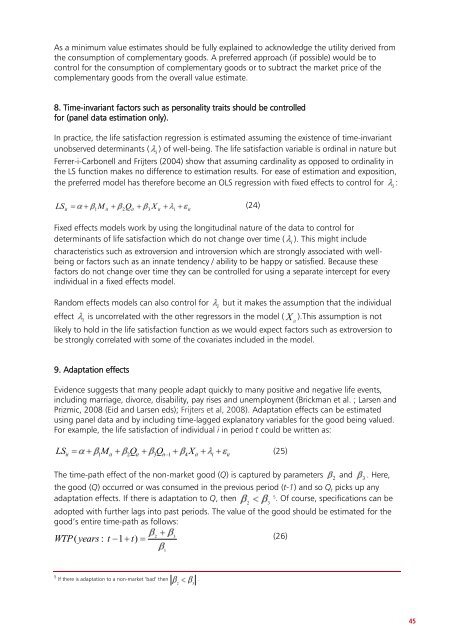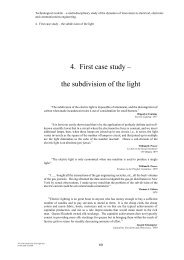Valuation Techniques for Social Cost-Benefit Analysis: - HM Treasury
Valuation Techniques for Social Cost-Benefit Analysis: - HM Treasury
Valuation Techniques for Social Cost-Benefit Analysis: - HM Treasury
You also want an ePaper? Increase the reach of your titles
YUMPU automatically turns print PDFs into web optimized ePapers that Google loves.
As a minimum value estimates should be fully explained to acknowledge the utility derived from<br />
the consumption of complementary goods. A preferred approach (if possible) would be to<br />
control <strong>for</strong> the consumption of complementary goods or to subtract the market price of the<br />
complementary goods from the overall value estimate.<br />
8. Time-invariant factors such as personality traits should be controlled<br />
<strong>for</strong> (panel data estimation only).<br />
In practice, the life satisfaction regression is estimated assuming the existence of time-invariant<br />
unobserved determinants ( i ) of well-being. The life satisfaction variable is ordinal in nature but<br />
Ferrer-i-Carbonell and Frijters (2004) show that assuming cardinality as opposed to ordinality in<br />
the LS function makes no difference to estimation results. For ease of estimation and exposition,<br />
the preferred model has there<strong>for</strong>e become an OLS regression with fixed effects to control <strong>for</strong> i :<br />
LSit M it Qit<br />
X<br />
(24)<br />
1 2 3 it i it<br />
Fixed effects models work by using the longitudinal nature of the data to control <strong>for</strong><br />
determinants of life satisfaction which do not change over time ( i ). This might include<br />
characteristics such as extroversion and introversion which are strongly associated with wellbeing<br />
or factors such as an innate tendency / ability to be happy or satisfied. Because these<br />
factors do not change over time they can be controlled <strong>for</strong> using a separate intercept <strong>for</strong> every<br />
individual in a fixed effects model.<br />
Random effects models can also control <strong>for</strong> i but it makes the assumption that the individual<br />
effect i is uncorrelated with the other regressors in the model ( X ).This assumption is not<br />
it<br />
likely to hold in the life satisfaction function as we would expect factors such as extroversion to<br />
be strongly correlated with some of the covariates included in the model.<br />
9. Adaptation effects<br />
Evidence suggests that many people adapt quickly to many positive and negative life events,<br />
including marriage, divorce, disability, pay rises and unemployment (Brickman et al. ; Larsen and<br />
Prizmic, 2008 (Eid and Larsen eds); Frijters et al, 2008). Adaptation effects can be estimated<br />
using panel data and by including time-lagged explanatory variables <strong>for</strong> the good being valued.<br />
For example, the life satisfaction of individual i in period t could be written as:<br />
LSit 1 Mit<br />
2Qit<br />
3Qit<br />
1 4X<br />
it i it<br />
(25)<br />
The time-path effect of the non-market good (Q) is captured by parameters 2 and 3 . Here,<br />
the good (Q) occurred or was consumed in the previous period (t-1) and so Qt picks up any<br />
adaptation effects. If there is adaptation to Q, then<br />
5 . Of course, specifications can be<br />
adopted with further lags into past periods. The value of the good should be estimated <strong>for</strong> the<br />
good‘s entire time-path as follows:<br />
2 3<br />
WTP ( years : t 1 t)<br />
(26)<br />
5 If there is adaptation to a non-market ‗bad‘ then<br />
1<br />
2<br />
.<br />
3<br />
2<br />
3<br />
45





![AIRTO [Professor Dr Brian Blunden] - HM Treasury](https://img.yumpu.com/15492848/1/184x260/airto-professor-dr-brian-blunden-hm-treasury.jpg?quality=85)










